If you want to rank content, a page, or a website on Google, you need to ensure that it satisfies on page SEO checklist. Otherwise, you are gonna face a lot of problems later on.
But stop worrying, as I (Reshaeel Sarwar) will be explaining each and every step you need to follow while involved in SEO on page activities.
Whether you are working on a Shopify store, a blog, a local business, or any affiliate site, this guide covers all the On page SEO factors you could need.
Table of Contents
ToggleWhat Is On Page SEO?
It is a practice of optimizing webpages for higher traffic potential and improved user experience.
Doing a proper onsite SEO can help Google identify your website and rank for better performance.
Now that we understand the ‘what,’ let’s dive into the ‘how’ with the complete 2025 on-page SEO checklist, which covers every essential element.
Complete On Page SEO Checklist for 2025
You can use multiple tools (Semrush, Ahrefs, or Screaming Frog), but I will be showing you examples using Semrush. The steps include:
Step 01: Identify Target Keywords
Keywords (or queries) are words or questions that users search on search engines like Google, Bing, Yandex, etc. So this forms the base for your On page SEO.
Before I begin, let it be sure you know the following checks about keywords:
- Volume: Shows monthly users
- Keyword Difficulty: How hard is it to rank for the keyword in the top 10 Google SERP results?
- Intention: Indicates the interest of the user
Let’s learn to identify keywords with a quick example!
Suppose you run a “Mega Shoe Store” in the United States and definitely “office shoes” might be a good keyword to start with.
You need to look the review of the keyword, as follows:
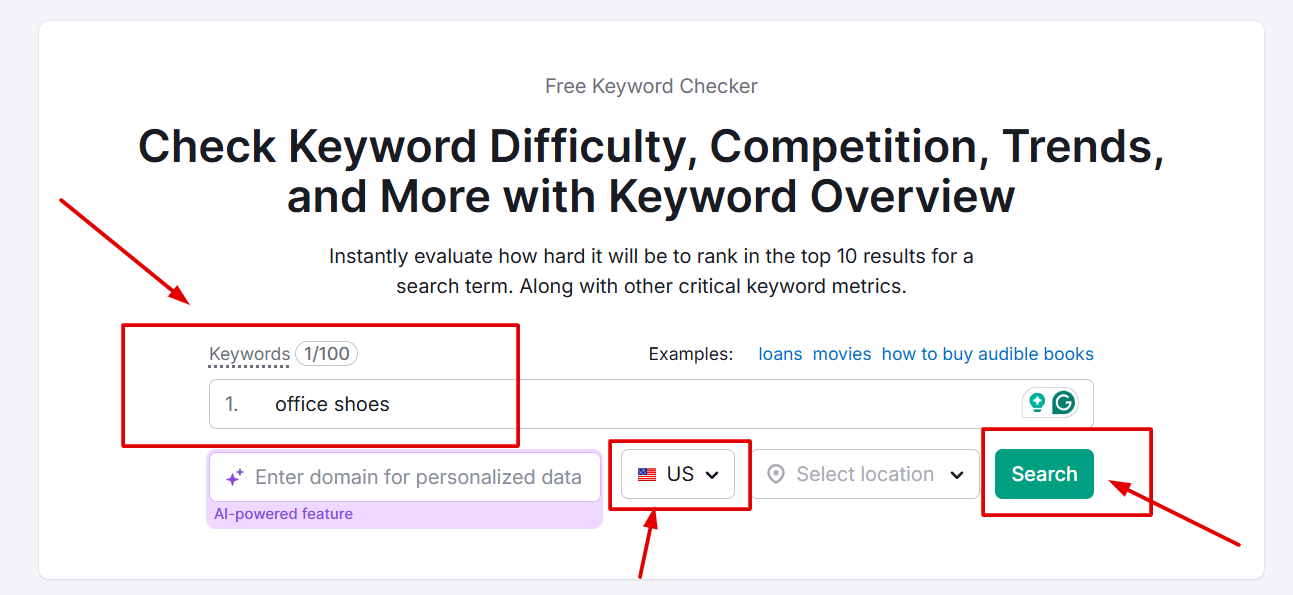
This keyword has a good volume and has a Search Volume of 5.4K and KD of 34, as shown in the following picture. It means you have to put in so much effort to rank your website page for this keyword.
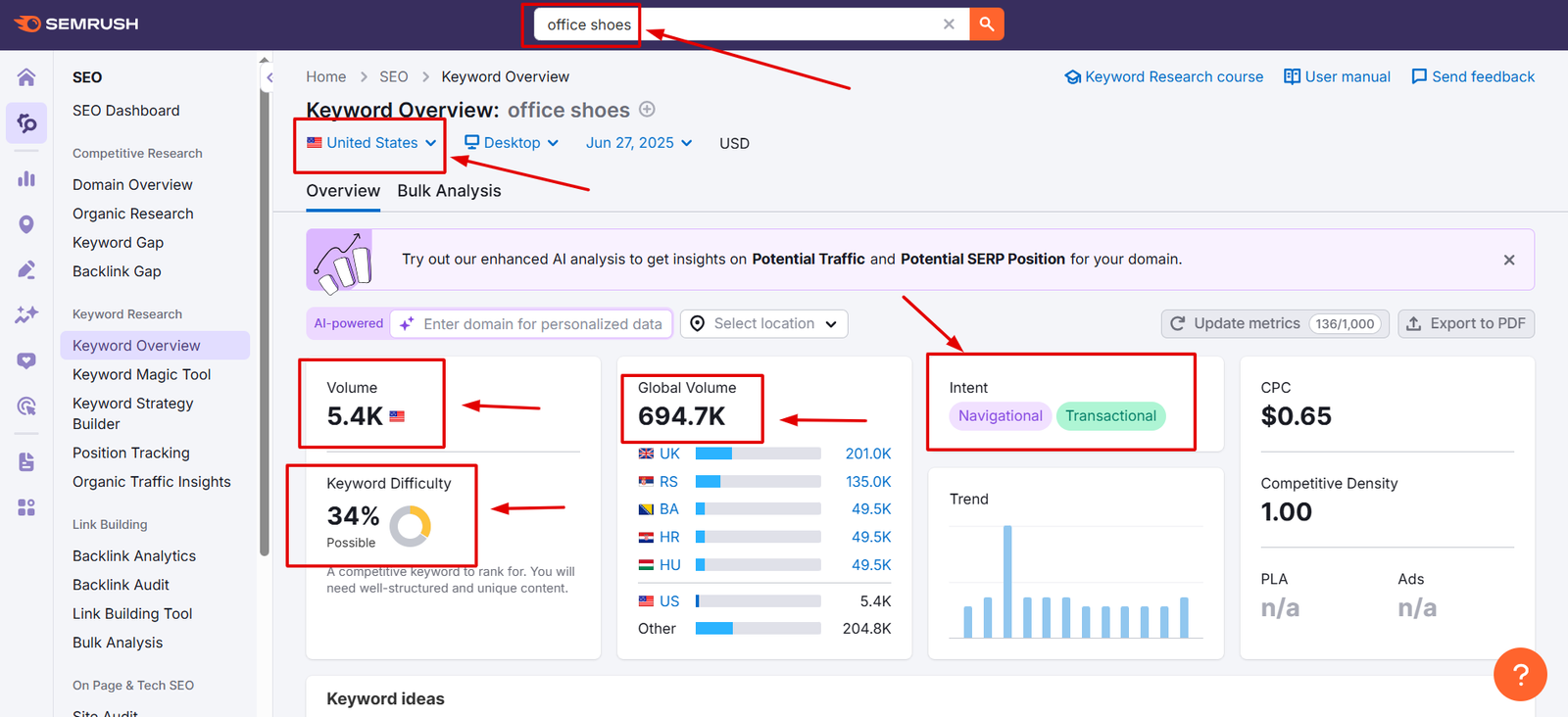
Now when we search directly on Google, we get links to official stores, which are selling office shoes in the United States.

Which indicates that you can rank your product page for this keyword, as the user’s intention for the keyword is also either ‘Navigational’ or ‘Transactional’.
Let’s Find its Supporting Keywords!
These are also known as Latent Semantic Index (LSI), Child Keywords, or Secondary Keywords.
Steps are simple:
- Go to the Keyword Magic Tool
- Type your keyword “Office Shoes”
- Select the location i.e., United States
- Click ‘Search’
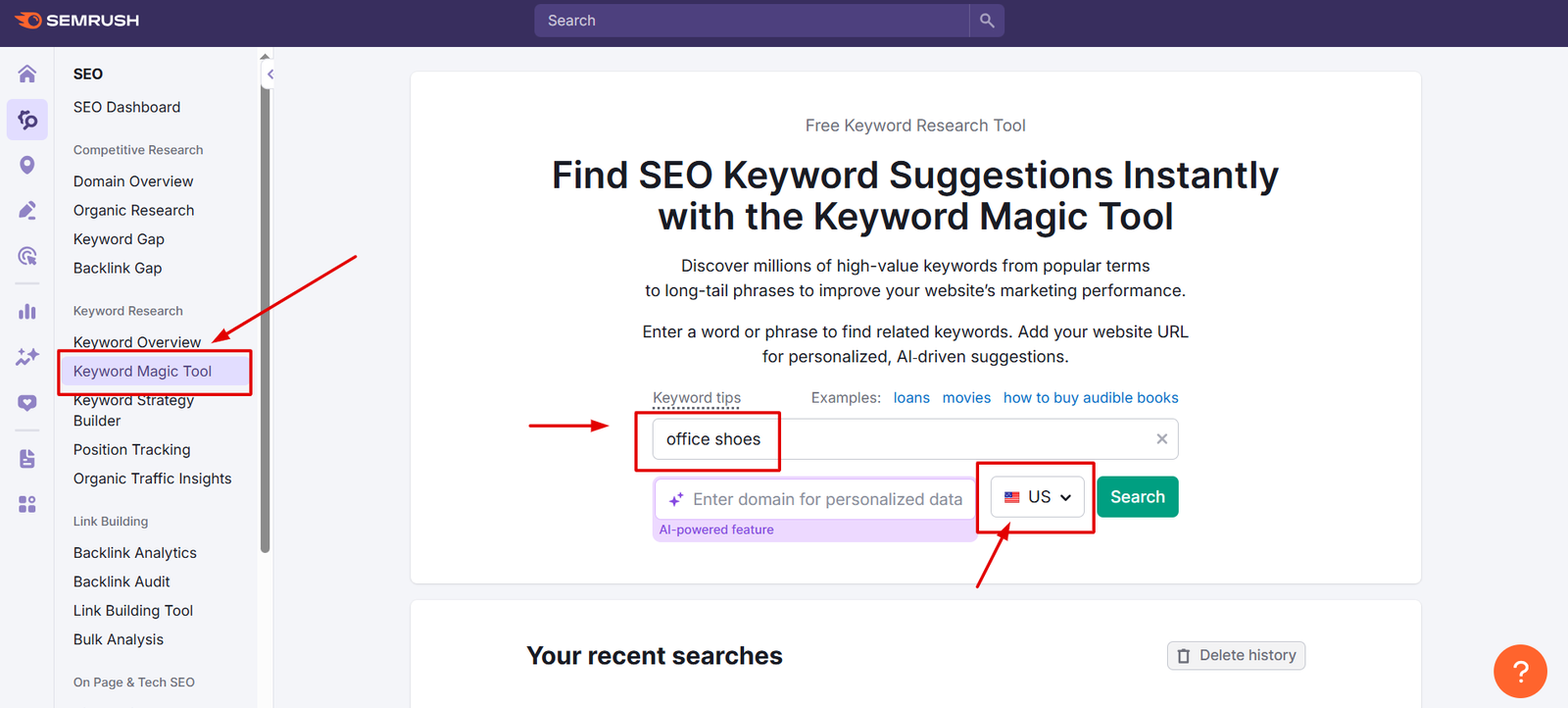
After that, choose the intent of keywords i.e., Navigational & Transactional and you will get a detailed list of keywords targeting the same intent that “Office Shoes” is targeting.

This is how you find the right primary and secondary keywords to write perfect content for your “Office Shoes Sales Page”
Step 02: Optimize the Title Tag
Meta Title or Title Tags tells users what the specific page is about. For example, you search “Office Shoes” and the following title tags appear on screen.
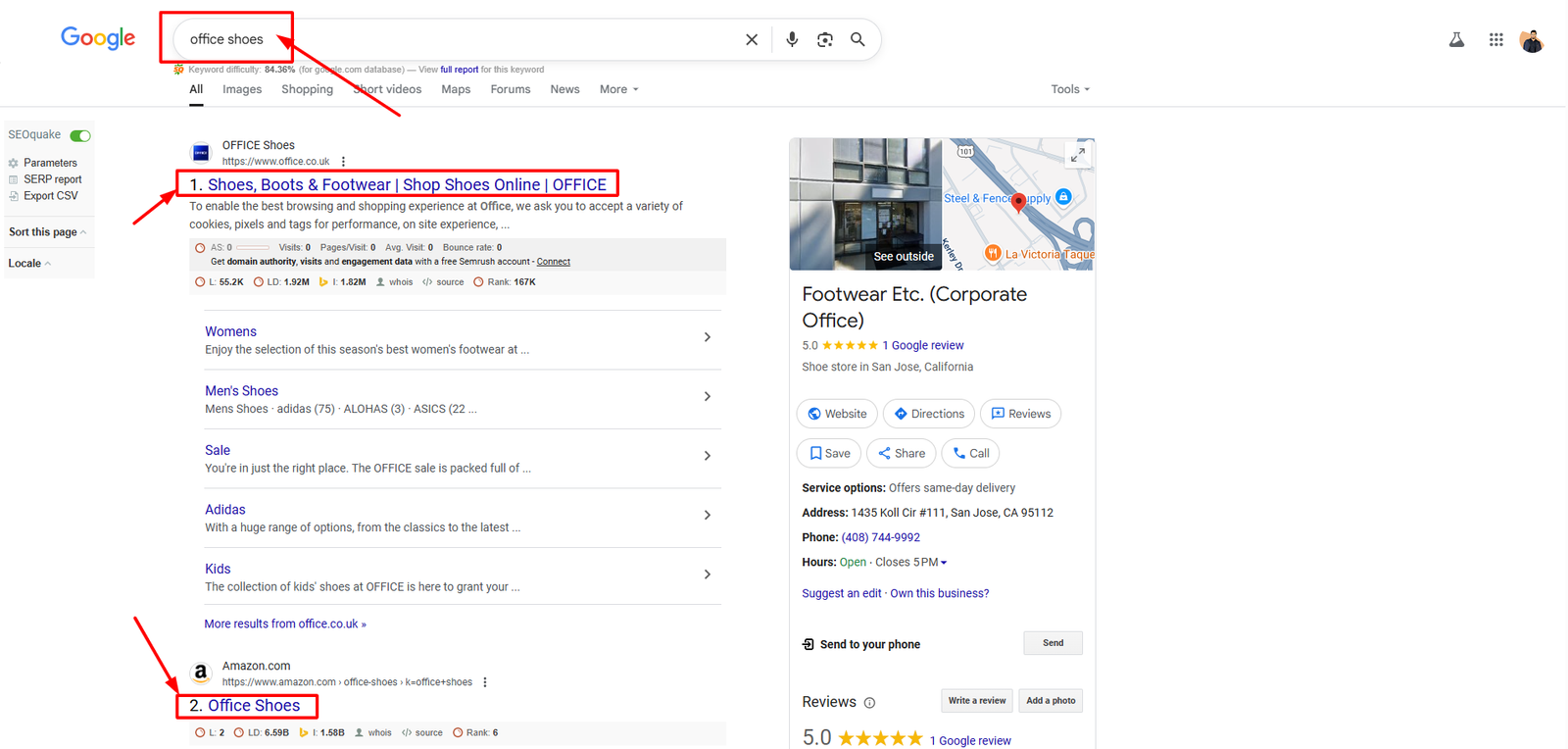
Its html source title will be:
| <title>Shoes, Boots & Footwear | Shop Shoes Online | OFFICE</title> |
To optimize a title tag, you should ensure the following SEO tactics:
- Try to include your main keyword early in the title
- Use clear and accurate wording that reflects what the content is about
- Add related secondary keywords where they fit naturally without forcing them in
- Keep your title under 60 characters or around 600 pixels wide so it does not get cut off in search results
![]()
You can also use On Page SEO Checker Tool in the Semrush to check whether your generated title tags are optimized or not.
Just for example, we search any random domain and click “Get Ideas”
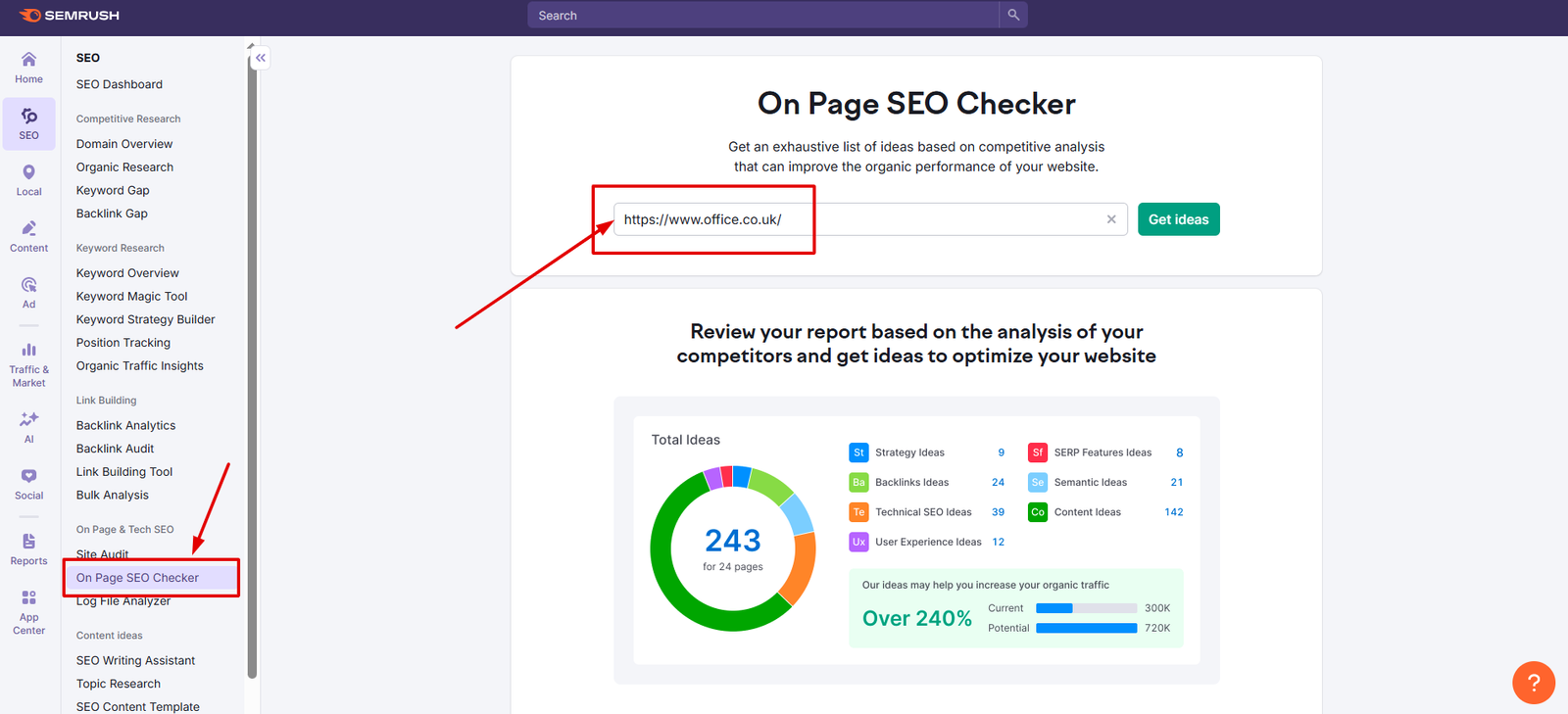
After that, you just need to check if the content has targeted keywords or not.
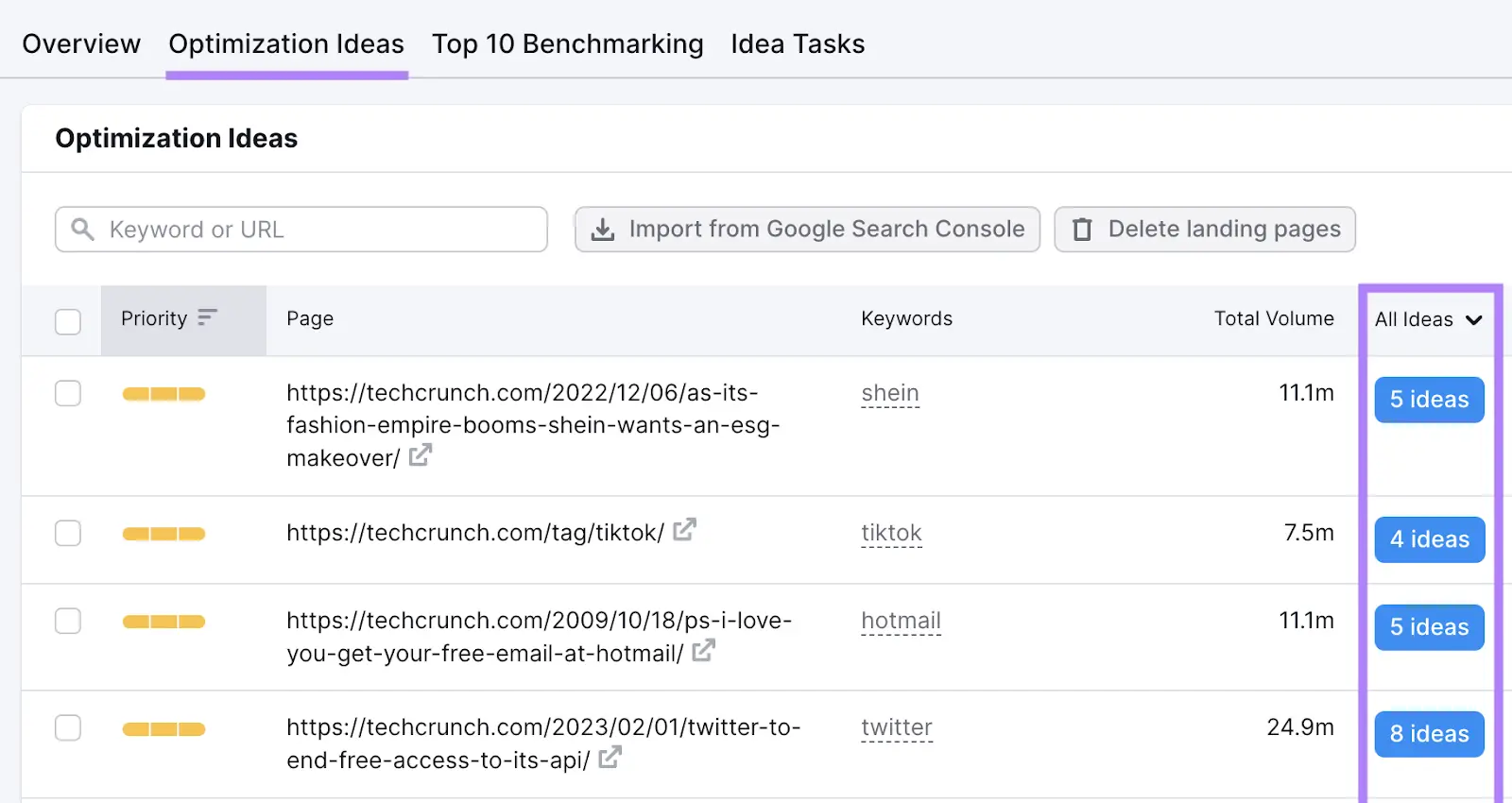
Step 03: Write a Meta Description That Increases Click Through Rate (CTR)
A meta description is a short summary of a web page’s content. It appears in search engine results just below the page title and URL.
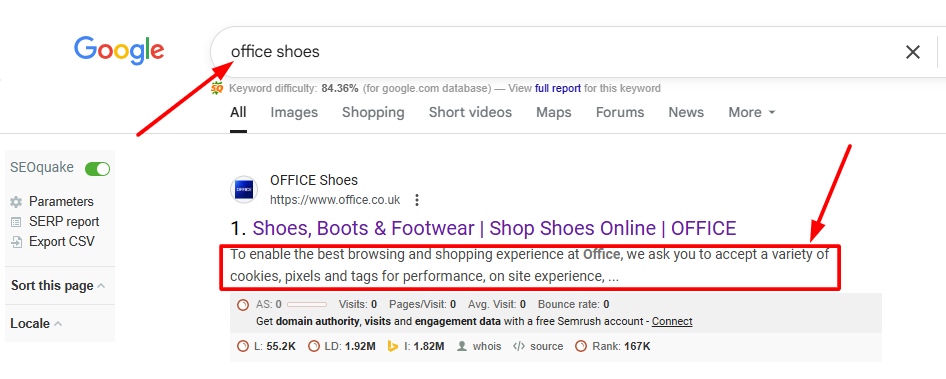
And its html code is:
| <meta name=”description” content=”Meta description here.”> |
Always remember that meta description helps to increase click through rate, and it is not a direct ranking factor. Plus, not every line appearing under the Meta Title in SERPs is a meta description. It might be any other line that the crawler found more relevant to the query. But still, it plays a key role in website SEO.
Steps to Optimize Meta Description
- Keep it under 160 characters so it doesn’t get cut off
- Summarize the page content clearly and naturally
- Include your primary keyword to align with search intent
- Use action words (like “learn,” “discover,” “find out“) to draw attention
You can also use the on page SEO checker to see if your meta description contains necessary keywords or not.
Bonus ABC FormulaNot the same format fits for every description. This is why I recommend using the ABC formula to create an engaging, compelling, and funnel description for the user. Plus, I also recommend SEO content writers to write meta descriptions as an elaborated version of the Meta title.
|
Step 04: Check the URL Slug for SEO-Friendliness
You have to focus on creating URL Slug that are SEO friendly and help Google and users understand what the page is about. This is because it is a unique portion of a page which describes the page before any click is made.
For example, I have shown one of the URL Slugs of an article written by me, as shown below.
![]()
Steps to Optimize URL Slug
- Keep URLs short and clean. A simple URL like how to find keyword cannibalization is easier to read and remember than something long like a complete step by step keyword cannibalization guide for 2025.
- Use your main keyword in the URL. In this case, keyword cannibalization is the focus, and it fits naturally in how to find keyword cannibalization.
- Make the URL clear and meaningful. How to find keyword cannibalization tells both users and search engines exactly what the page is about. Avoid confusing URLs like kc-guide-001-page.
- Use hyphens to separate words. How-to-find-keyword-cannibalization is much easier to read than howtofindkeywordcannibalization or how_to_find_keyword_cannibalization.
- Avoid using special characters. Stick with lowercase letters, numbers, and hyphens only. Characters like question marks or symbols can cause errors and lower readability.
- Remove unnecessary filler words. You don’t need words like “the,” “and,” or “a” in the URL. How-to-find-keyword-cannibalization works better than how-to-find-the-keyword-cannibalization.
- Don’t include dates or temporary words that can go out of date. How to Find Keyword Cannibalization stays relevant over time, unlike how-to-find-keyword-cannibalization-2025.
Step 05: Apply Schema Markup
Schema markup is a code that you can add to the HTML of a website so that Google can better understand more about it. Additionally, it helps Google to showcase different services or characteristics of a website.
Google uses these details to display multiple features of a website, including reviews, ratings, discounts, prices, or even dates. For reference, check the following image:

Schema Markup Types That Google Supports
| Researched by Reshaeel Sarwar | ||
|---|---|---|
| Schema Type | Purpose / Enhancements | Common Use Case |
| Article | Displays headline, date, and sometimes carousels in SERPs | Blog posts, news articles |
| News Article | Highlights news-specific content | News publishing sites |
| Blog Posting | Optimizes blog content specifically | Personal or business blogs |
| Person | Shows personal data like name, title, and image | Author pages, team profiles |
| Product | Displays price, availability, reviews | eCommerce product pages |
| Review / Rating | Adds star ratings and review snippets | Products, services, books, movies |
| Local Business | Highlights business hours, address, and contact info | Local service providers and stores |
| Organization | Displays company details and social profiles | Company about pages |
| Course | Lists course name, provider, and description | Online course pages, LMS platforms |
| Event | Shows date, time, and location for events | Webinars, conferences, concerts |
| FAQ Page | Shows expandable Q&A in search results | FAQ sections on service or product pages |
| How To | Displays step-by-step guides with optional images | Tutorials, DIY guides |
| Recipe | Displays cook time, ingredients, and ratings | Food blogs, cooking websites |
| Video | Adds video thumbnail, length, and upload date | Video content and media sites |
| Breadcrumb List | Shows page path in results, improving navigation | All types of structured websites |
| Job Posting | Displays job title, location, salary, and apply link | Career and job board sites |
| Book | Lists details like title, author, ISBN, and reviews | Book reviews or online bookshops |
Let’s discuss it with an example!
I searched “Classic birthday cake” and found that its “Recipe Schema” is really helpful to let users explore its certain features. These include its recipe time, possible ingredients, ratings, etc.
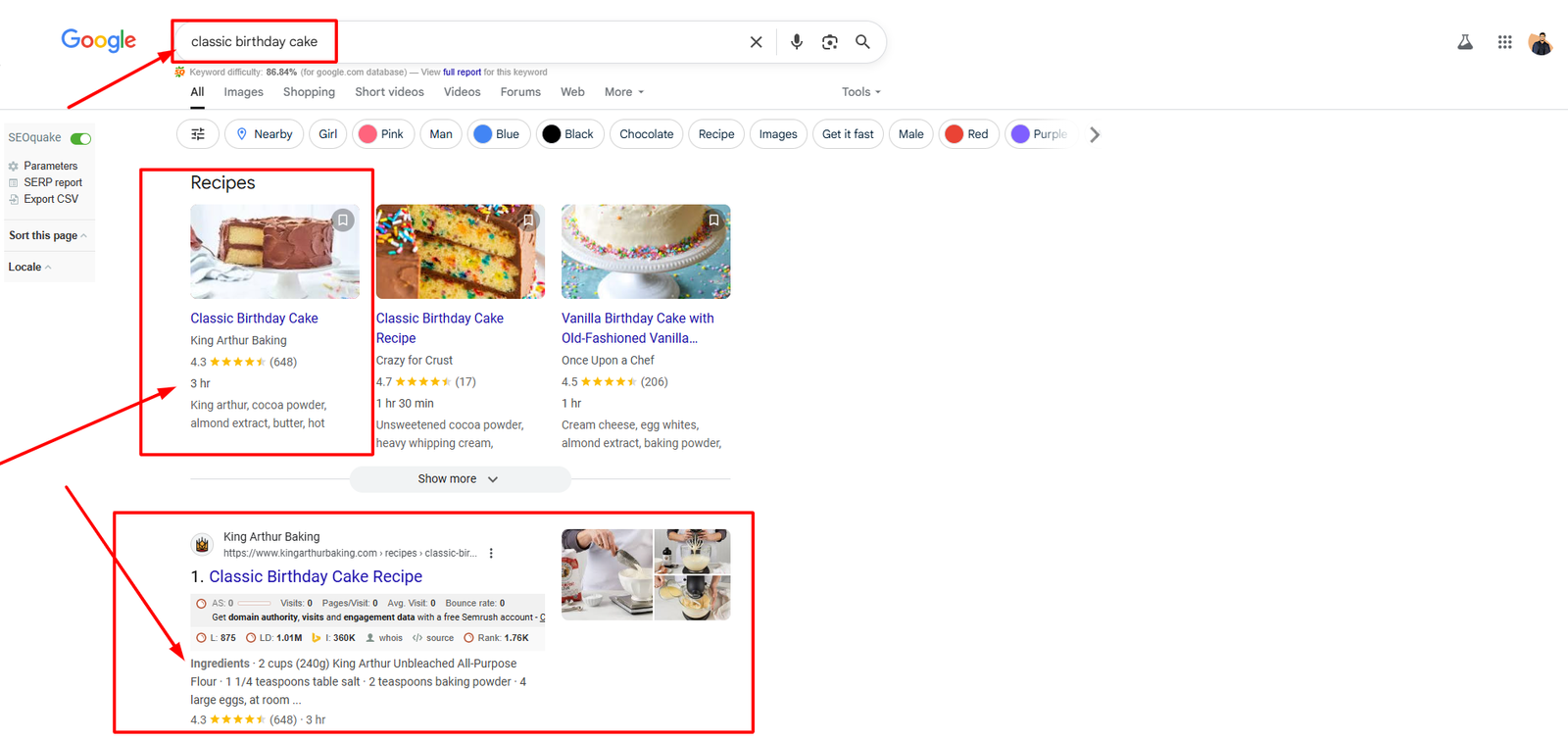
Guys, this is one of the advanced techniques in On page SEO Checklist. Additionally, you can also use the Structured Data Markup Helper to add schema markup to your page or website.
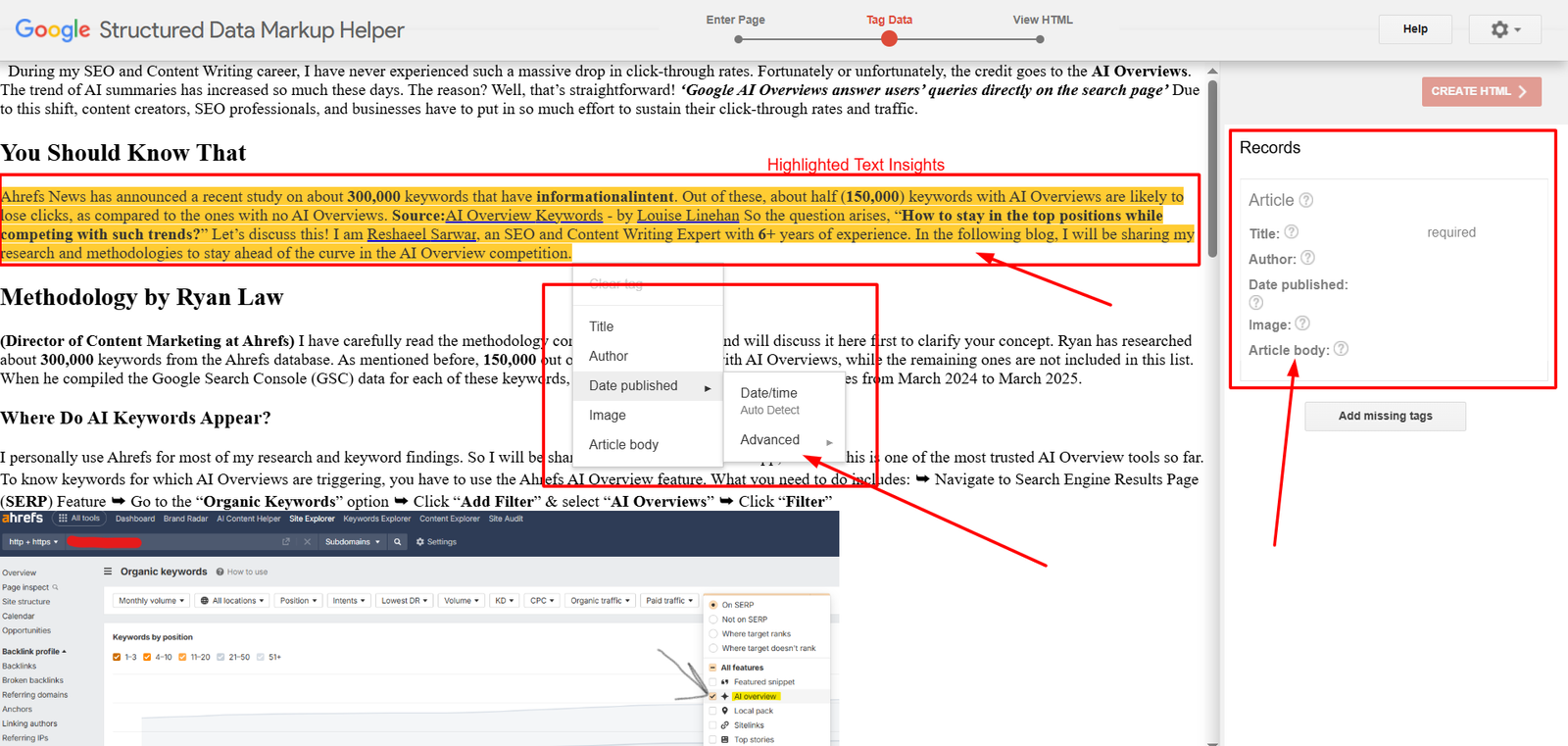
As you see, this is how you can also highlight any image or text in the content to create schema structure for it, with no effort. It’s that easy!
Step 06: Add Engaging Visual Content
This is another powerful essential of on-page seo in 2025. Visuals engage your users emotionally with anything you are trying to sell. It can be either your story, a product, or a service.
For example, I am an SEO expert and offer on page seo services, so it will be a good way for me to make different videos about my work, projects, and services that I can give to my clients. This way, it would be a good initiative to win high-ticket clients or projects.
Else, I can also make picture-based ads to showcase what I have to offer.
So this is necessary for you to make videos and images in high quality, which will definitely boost your on site seo.
Step 07: Add Internal Links to Improve Navigation
Internal linking is the practice of linking one page of your website to another page within the same domain.
Purpose of Internal Linking
- Guides users to related or important content
- Distributes page authority (link equity) across your site
- Helps search engines crawl and index your pages better
- Boosts rankings for specific pages by signaling their relevance
- Improves user experience by offering helpful content journeys
Internal Linking Best Practices (I Prefer)
- Use descriptive and keyword-rich anchor text
- Link to relevant pages only. Don’t force unrelated links
- Place important internal links higher up in the content
- Don’t overload with too many links, keep it natural
- Use a silo structure, group related content under topics
- Link back to pillar or cornerstone content regularly
- Avoid orphan pages (pages with no internal links pointing to them)
Example: A blog post about “Finding keyword cannibaization” linking to another post like “How to fix keyword cannibalization“.
Step 08: Mark Up Subheadings with Header Tags
Header tags range from H1 to H6, and they help Search Engine to easily navigate through you webpage.
Basically, the header tags follow a Nested Hierarchy, as shown in the following image:
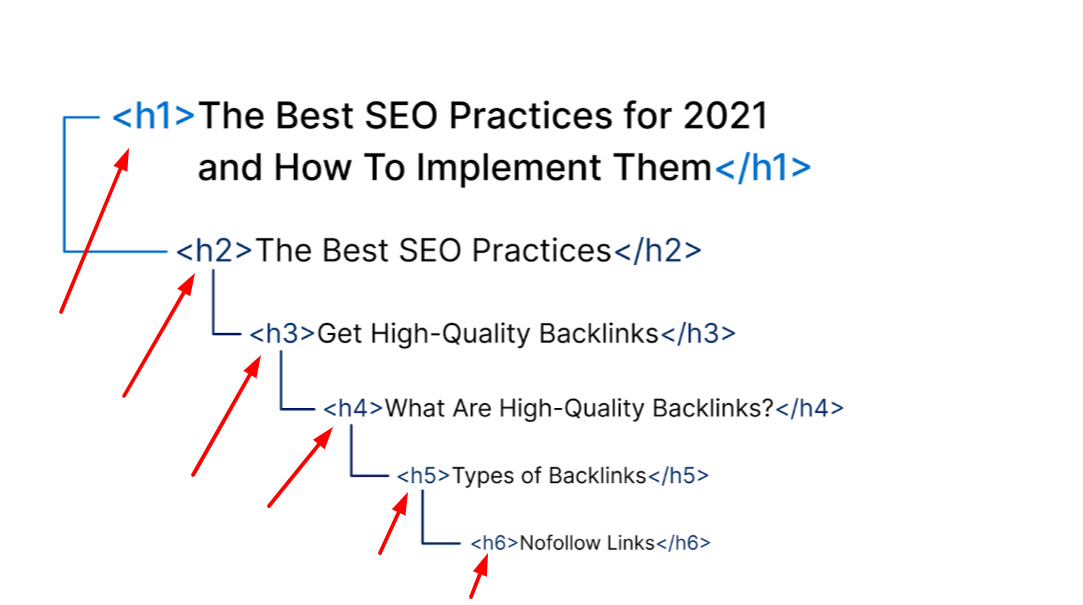
Steps To Optimize Include
- Use only one H1 tag on each page
- Add your main keyword in the H1 naturally
- Make sure the H1 clearly explains what the page is about
- Use H2 and H3 to break your content into sections
- Add related or secondary keywords in subheadings where they fit
- Keep all headings short and easy to understand
- Follow the proper order like H1 first, then H2, then H3
- Do not skip heading levels or use them just to make text look bigger
- Avoid adding too many keywords into headings
- Write your headings in a way that answers user questions
- Use CSS to style your headings instead of using the wrong tags
- Make sure every heading helps guide the reader through the content
Step 09: Add Target Keywords to Your Body Content
Never insert or stuff keywords in your content. Rather, try to integrate them naturally in the content, which seems to be helpful for user. Also, Google appreciates this practice and rank your page for the targeted keywords.
So let’s discuss how you can do this!
- Use your main keyword naturally in the first paragraph
- Add related terms to give context (like gift cards or in-app purchases)
- Include supporting topics that show expertise (like reward programs or offers)
- Use keyword variations where they fit naturally
- Check top-ranking pages to see:
- What keywords and phrases they use
- What related topics they cover
- How they place keywords in the content
